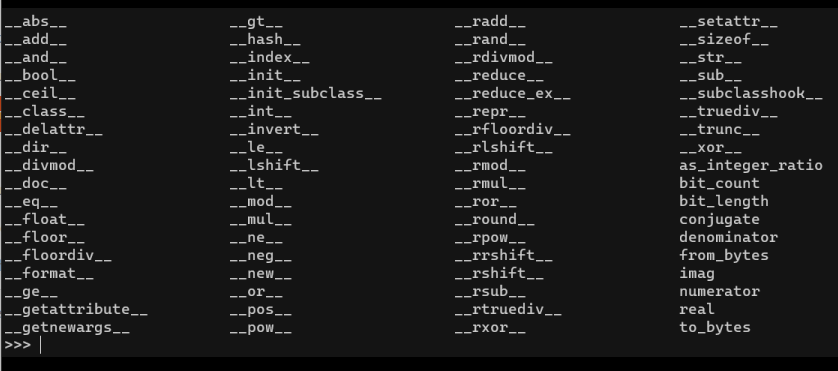Dunder or magic methods in Python
Last Updated :
01 Dec, 2023
Python Magic methods are the methods starting and ending with double underscores ‘__’. They are defined by built-in classes in Python and commonly used for operator overloading.
They are also called Dunder methods, Dunder here means “Double Under (Underscores)”.
Python Magic Methods
Built in classes define many magic methods, dir() function can show you magic methods inherited by a class.
Example:
This code displays the magic methods inherited by int class.
Output
['__abs__', '__add__', '__and__', '__bool__', '__ceil__', '__class__', '__delattr__', '__dir__', '__divmod__', '__doc__', '__eq__', '__float__', '__floor__', '__floordiv__', '__format__', '__ge__', '_...
Or, you can try cmd/terminal to get the list of magic functions in Python, open cmd or terminal, type python3 to go to the Python console, and type:
>>> dir(int)
Output:

Python Magic Methods
Below are the lists of Python magic methods and their uses.
Initialization and Construction
- __new__: To get called in an object’s instantiation.
- __init__: To get called by the __new__ method.
- __del__: It is the destructor.
Numeric magic methods
- __trunc__(self): Implements behavior for math.trunc()
- __ceil__(self): Implements behavior for math.ceil()
- __floor__(self): Implements behavior for math.floor()
- __round__(self,n): Implements behavior for the built-in round()
- __invert__(self): Implements behavior for inversion using the ~ operator.
- __abs__(self): Implements behavior for the built-in abs()
- __neg__(self): Implements behavior for negation
- __pos__(self): Implements behavior for unary positive
Arithmetic operators
- __add__(self, other): Implements behavior for math.trunc()
- __sub__(self, other): Implements behavior for math.ceil()
- __mul__(self, other): Implements behavior for math.floor()
- __floordiv__(self, other): Implements behavior for the built-in round()
- __div__(self, other): Implements behavior for inversion using the ~ operator.
- __truediv__(self, other): Implements behavior for the built-in abs()
- __mod__(self, other): Implements behavior for negation
- __divmod__(self, other): Implements behavior for unary positive
- __pow__: Implements behavior for exponents using the ** operator.
- __lshift__(self, other): Implements left bitwise shift using the << operator.
- __rshift__(self, other): Implements right bitwise shift using the >> operator.
- __and__(self, other): Implements bitwise and using the & operator.
- __or__(self, other): Implements bitwise or using the | operator.
- __xor__(self, other): Implements bitwise xor using the ^ operator.
String Magic Methods
- __str__(self): Defines behavior for when str() is called on an instance of your class.
- __repr__(self): To get called by built-int repr() method to return a machine readable representation of a type.
- __unicode__(self): This method to return an unicode string of a type.
- __format__(self, formatstr): return a new style of string.
- __hash__(self): It has to return an integer, and its result is used for quick key comparison in dictionaries.
- __nonzero__(self): Defines behavior for when bool() is called on an instance of your class.
- __dir__(self): This method to return a list of attributes of a class.
- __sizeof__(self): It return the size of the object.
Comparison magic methods
- __eq__(self, other): Defines behavior for the equality operator, ==.
- __ne__(self, other): Defines behavior for the inequality operator, !=.
- __lt__(self, other): Defines behavior for the less-than operator, <.
- __gt__(self, other): Defines behavior for the greater-than operator, >.
- __le__(self, other): Defines behavior for the less-than-or-equal-to operator, <=.
- __ge__(self, other): Defines behavior for the greater-than-or-equal-to operator, >=.
Dunder or Magic Methods in Python
Let’s see some of the Python magic methods with examples:
1. __init__ method
The __init__ method for initialization is invoked without any call, when an instance of a class is created, like constructors in certain other programming languages such as C++, Java, C#, PHP, etc.
These methods are the reason we can add two strings with the ‘+’ operator without any explicit typecasting.
Python3
class String:
def __init__(self, string):
self.string = string
if __name__ == '__main__':
string1 = String('Hello')
print(string1)
|
Output
<__main__.String object at 0x7f538c059050>
2. __repr__ method
__repr__ method in Python defines how an object is presented as a string.
The below snippet of code prints only the memory address of the string object. Let’s add a __repr__ method to represent our object.
Python3
class String:
def __init__(self, string):
self.string = string
def __repr__(self):
return 'Object: {}'.format(self.string)
if __name__ == '__main__':
string1 = String('Hello')
print(string1)
|
If we try to add a string to it:
Python3
class String:
def __init__(self, string):
self.string = string
def __repr__(self):
return 'Object: {}'.format(self.string)
if __name__ == '__main__':
string1 = String('Hello')
print(string1 +' world')
|
Output:
TypeError: unsupported operand type(s) for +: 'String' and 'str'
3. __add__ method
__add__ method in Python defines how will be the objects of a class added together. It is also known as overloaded addition operator.
Now add __add__ method to String class :
Python
class String:
def __init__(self, string):
self.string = string
def __repr__(self):
return 'Object: {}'.format(self.string)
def __add__(self, other):
return self.string + other
if __name__ == '__main__':
string1 = String('Hello')
print(string1 +' Geeks')
|
We have discussed some of the Python magic methods or Dunder methods. Magic methods in Python can be used to different functionalities in your class.
Hope you learn about Python magic methods from this article, and use it in your projects.
Share your thoughts in the comments
Please Login to comment...